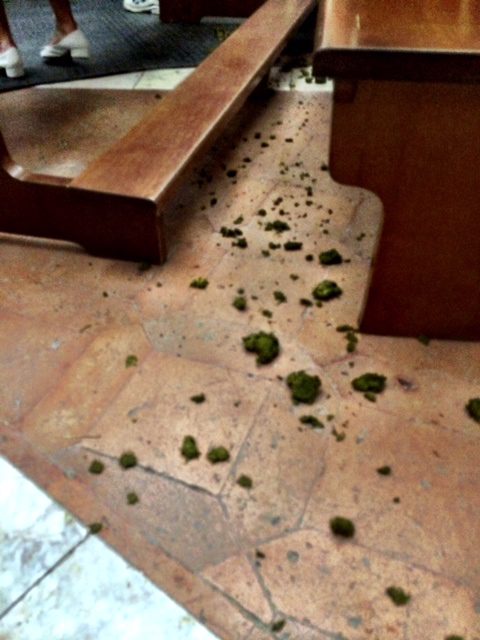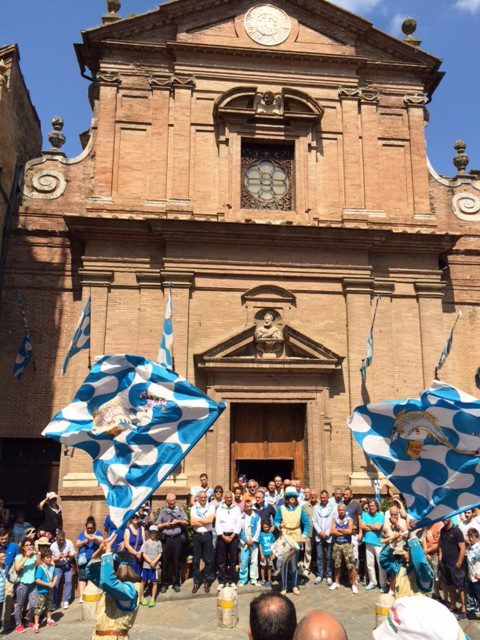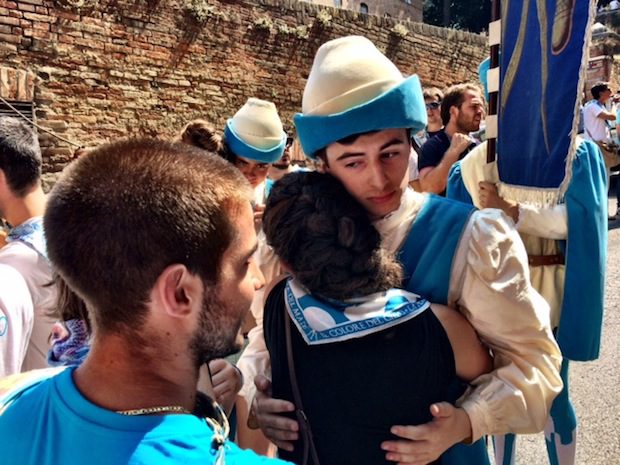Siena’s Glory

No matter what they tell you, when the horse shits in the church, it is no guarantee of anything. I’ll explain this later.
Today was Palio day in Siena. I began by going into the nearby church of San Domenico, and praying for a few people back home in front of the Holy Head of St. Catherine of Siena. She died in the 14th century in Rome, and was buried in the church of St. Maria sopra Minerva, near the Pantheon. The Sienese wanted their beloved saint back home, but the Romans wouldn’t give her up. So a delegation went to Rome, asked for some time alone with her body, severed her head, put it in a sack, and lit out for Siena. The story goes that when a guard stopped them and asked to see what was in the bag, they opened it, and saw nothing but rose petals — a miracle. The Holy Head can now be seen inside a reliquary on a high altar in a side chapel. I offered prayers for a friend’s recently dead grandfather, and for my family.
This is normal in Siena. God, I love this place.
I made my way up and down the steep medieval streets and over to San Giuseppe, the parish church of the Onda contrada. Onda commissioned the church in the 1500s, and finished it a century later. Like every other contrada, the Onda devotees gather on Palio day in their contrada church for the blessing of the horse.
“If the horse leaves a little present on the floor of the church, it’s an extremely good omen,” said a contradaioli, standing next to us in the massing crowd. “If Onda wins, the droppings will be preserved, and treasured.”
A nonna opened a side door to let people in to the small church. She shoved Sordello and I to the side, telling us that only baptized members of the contrada were allowed in to see the rite. Our contradaioli friend very generously pulled some strings, and convinced nonna to let us pass after the locals were inside. Had we not been able to go in, I would have been fine with it. I admire a woman who knows her neighborhood, and who won’t let stranieri in on the neighborhood’s high holy day.
But it was a true blessing that we did make it inside, because what I saw was one of the most exciting and moving things I have ever witnessed. The crowd fell silent when Onda’s horse was led in. The stout Monsignor Gaetano, the barrel-chested dean of the Duomo cathedral and Onda’s chaplain, stood in front of the altar with a coterie of contradaioli in traditional medieval costume, awaiting the steed. In came the horse, and Don Gaetano, wearing an aquamarine-and-white Onda fazzoletto (scarf) over his vestments, invoked the Holy Trinity and began his prayers.
The horse raised his tail and shat on the floor of the church. Don Gaetano smiled as he walked delicately around the horse, blessing him with holy water from the aspergillum, invoking the Father, the Son, and the Holy Spirit over and over. The monsignor returned to the altar, said his final prayers, and in a booming voice, ordered, “Go forth and bring back a victory!”
Not a word was said until the horse was led out, but once that had happened, the crowd burst into a stentorian performance of Onda’s Palio hymn that shook the church to its foundations. The contradaoli bared their souls. I have never heard an actual hymn sung with so much heart, with so much force. I took a video of it, but there’s no way to capture the power of that moment, in that little church on top of a Sienese hill. I am certain that this is one of the most extraordinary moments of my life, a small ritual that made this entire trip worth it.
As we left the church, Sordello and I inspected the equine augury. The men of the contrada had already begun surrounding it with prayer benches to protect it:
This is normal in Siena. Did I mention how much I love this place?
We stood in front of the small piazza outside San Giuseppe to watch the flag bearers of Onda perform, accompanied by a snare drummer. How long has this ritual been here? Who knows? It was impressive:
After the flag display ended, family members embraced the costumed men and teenage boys, wishing them well. Here is mamma telling her son how proud she is of him. Look at those Sienese eyes:
It was by then four o’clock, in the highest heat of the day. We went back to our hotel to cool off for a bit before the race itself. If you want to be on the campo for the race, you need to arrive early, and prepare to wait in the center field for a long time. You get to see the amazing parade of contradaioli in their medieval costumes, but Europe’s heat wave kept us away. Neither one of us Palio rookies had the stamina for that, so we made our way down to Onda to watch the race on TV in a bar.
The bar, a simple, everyday neighborhood hangout, had a tiny TV hanging on the wall. The nervous bartender served us red wine in plastic cups, and we stood with a surprisingly sparse crowd — everybody else was in the campo — staring at the TV, waiting for the race to begin. Though there are 17 contrada in Siena, only ten horses run in each Palio. Their placement on the track is decided by drawing lots at the last minute. The tenth horse has to stay back, which means he almost certainly can’t win, but he does have the power to start the race. Sometimes he holds the race start for a long time — this, to try to get some other rider with whom he might have made a deal into a good position. Tonight’s Palio didn’t start for an hour.
Suddenly, the rope dropped, and the horses and their jockeys were off. The entire race takes about 75 seconds, and involves three laps around the perimeter of the Campo. The jockeys ride bareback, which is very tough. Plus, there are two harsh 90-degree turns on the track. As the last lap began, Torre (Tower), the hated rival of Onda (Wave) was in the lead, but Onda was coming up fast, and looked as if he would overtake the Torre horse. But then, at the last sharp turn, Onda nicked the sharp edge of the side wall, throwing the horse off stride. Torre galloped across the finish line a winner. Onda was second.
This was literally the worst thing that can happen to a contrada. The loser is not thought to be the last horse in the race, but the one who came in second. So Onda lost the Palio to its bitter enemies, the scoundrels from Torre.
The somber Onda crowd tumbled out of the Campo and down solemn via Giovanni Dupré. Some were zombie like; others were openly weeping. “Everything! We’ve lost everything!” wailed a teenage boy, his palms flat against his cheeks. Little girls slumped against the brick walls, sobbing. The phrase “the agony of defeat” came to mind, and I thought about photographing some of the startling scenes of human vulnerability, but Sordello warned against it. He was right. These people were hurting badly. It didn’t feel right to expose them.
I ran into our old contradaioli friend in the street, looking very low indeed. “This is just about the worst thing that could have happened,” he said. To come in second place to Torre — that’s harsh.
“All the other contrada will be partying in the streets all night,” he said, “but not us. Not after this. Nobody will be in a mood to party. Right now, Torre is going over to its church, and everybody will sing a Te Deum. Then the party will begin. They will open up to the whole city, and there will be lots of food and wine. You might want to go over to the church to see what that’s like.”
“We can’t do that,” I said. “It’s Torre. That wouldn’t be right.”
The contradaioli smiled, signaling that he appreciated our loyalty.
“There are two times when you can say that you have really seen the Palio,” he said. “When your contrada wins, and when it loses. This is a hard thing for all of us, but we are here. We celebrate together when we win, and we comfort each other when we lose.”
Sordello and I felt out of place standing around any longer, like strangers at the funeral of someone we barely knew. The Contrada dell’Onda needed to mourn with itself. It was time for the strangers to bow out. We walked up the hill past the church of San Giuseppe, took off our Onda fazzoletti — the custom is that only the winning contrada has the right to show its colors after the Palio — and meandered over into the Tortuca quarter, where we found a table in an osteria and ordered food. I had pasta with pesto:
The TV at the end of the room replayed the race over and over, but damned if it wasn’t interesting each time to watch how the Torre and Onda jockeys competed. The Siena TV channel switched to live coverage of the crowd carrying the Torre jockey through the streets on their shoulders, and into the contrada church. As we sat eating our pasta and watching TV, the people jamming that church were waving contrada flags and going berserk with joy. The palio — a large painted banner showing images of Siena, and dominated by an image of the Virgin Mary, was carried into the church on a long pole. People reached out to touch the garment. It was put in place next to the altar, and the jockey kneeled at the altar to pray. The camera held a close-up of him giving thanks, his head in his hands crying, then raising them to the sky, speaking to God and the Holy Virgin. He finally crossed himself. It was an almost unbelievable event. The crowd was so passionate you would have thought the nation had won a great war.
We paid our bill and walked toward home before the Te Deum started, but I loved thinking about how the first thing a winning contrada does is return to its contrada church and offer a Te Deum to God for having granted victory. This city is indescribably Catholic. It’s like a fresco; Catholicism has seeped into the fabric of their everyday life in ways that astonish. You don’t see this in France, for example. The Italians have a genius for religion and culture. I never thought I would have so much fun at a horse race, but the Palio has been more of a religious event, or at least a liturgical one. I am in awe of it, and of these Sienese people.
“What is it about Italians?” I told Sordello, over pasta in pesto. “They don’t know how to govern themselves, but man, they sure know how to live.”
“Can you think of one people that can govern itself, but also knows how to live?” he said. Sordello lives in New Orleans, another city with bad government, but good living.
I could not. I do believe that if you are born in Siena, or baptized into a contrada, you would never want to leave something so special, and people so dear. Holy Heads of medieval mystics, blessing the horse in the church, then protecting horse shit as a potential relic, the medieval parade, the race itself dedicated to the Blessed Virgin, the running to the church to sing a Te Deum before feasting.
This is life as it ought to be lived. And I got to see it, and even be a part of it. Thanks be to God — and thanks to my wife Julie for letting me come here, and for Ron Herzman and his amazing team for inviting me and making it special for us.
Hide your quenelles, we’re off to Lyon tomorrow.




Subscribe for as little as $5/mo to start commenting on Rod’s blog.